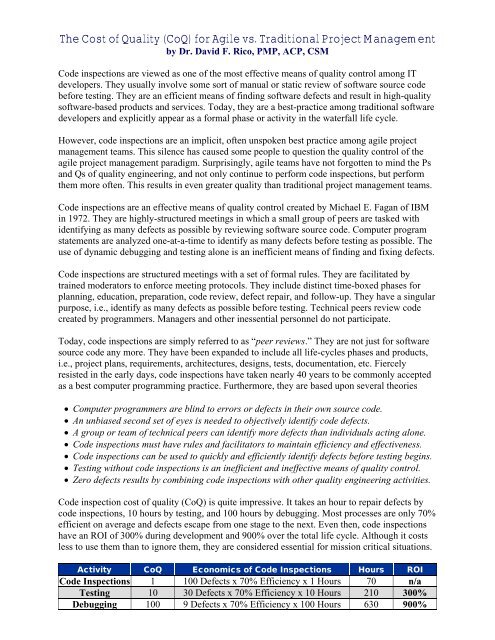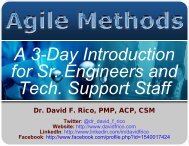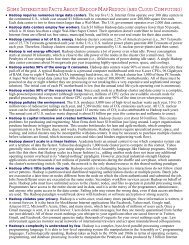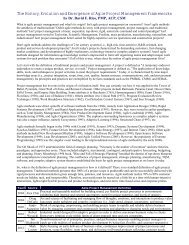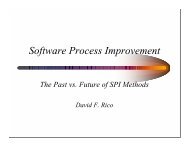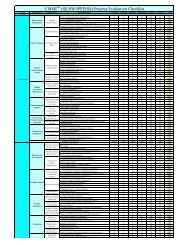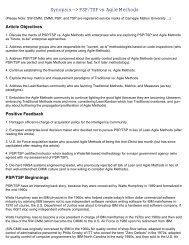The Cost of Quality (CoQ) for Agile vs. Traditional ... - David F. Rico
The Cost of Quality (CoQ) for Agile vs. Traditional ... - David F. Rico
The Cost of Quality (CoQ) for Agile vs. Traditional ... - David F. Rico
You also want an ePaper? Increase the reach of your titles
YUMPU automatically turns print PDFs into web optimized ePapers that Google loves.
<strong>The</strong> <strong>Cost</strong> <strong>of</strong> <strong>Quality</strong> (<strong>CoQ</strong>) <strong>for</strong> <strong>Agile</strong> <strong>vs</strong>. <strong>Traditional</strong> Project Management<br />
by Dr. <strong>David</strong> F. <strong>Rico</strong>, PMP, ACP, CSM<br />
Code inspections are viewed as one <strong>of</strong> the most effective means <strong>of</strong> quality control among IT<br />
developers. <strong>The</strong>y usually involve some sort <strong>of</strong> manual or static review <strong>of</strong> s<strong>of</strong>tware source code<br />
be<strong>for</strong>e testing. <strong>The</strong>y are an efficient means <strong>of</strong> finding s<strong>of</strong>tware defects and result in high-quality<br />
s<strong>of</strong>tware-based products and services. Today, they are a best-practice among traditional s<strong>of</strong>tware<br />
developers and explicitly appear as a <strong>for</strong>mal phase or activity in the waterfall life cycle.<br />
However, code inspections are an implicit, <strong>of</strong>ten unspoken best practice among agile project<br />
management teams. This silence has caused some people to question the quality control <strong>of</strong> the<br />
agile project management paradigm. Surprisingly, agile teams have not <strong>for</strong>gotten to mind the Ps<br />
and Qs <strong>of</strong> quality engineering, and not only continue to per<strong>for</strong>m code inspections, but per<strong>for</strong>m<br />
them more <strong>of</strong>ten. This results in even greater quality than traditional project management teams.<br />
Code inspections are an effective means <strong>of</strong> quality control created by Michael E. Fagan <strong>of</strong> IBM<br />
in 1972. <strong>The</strong>y are highly-structured meetings in which a small group <strong>of</strong> peers are tasked with<br />
identifying as many defects as possible by reviewing s<strong>of</strong>tware source code. Computer program<br />
statements are analyzed one-at-a-time to identify as many defects be<strong>for</strong>e testing as possible. <strong>The</strong><br />
use <strong>of</strong> dynamic debugging and testing alone is an inefficient means <strong>of</strong> finding and fixing defects.<br />
Code inspections are structured meetings with a set <strong>of</strong> <strong>for</strong>mal rules. <strong>The</strong>y are facilitated by<br />
trained moderators to en<strong>for</strong>ce meeting protocols. <strong>The</strong>y include distinct time-boxed phases <strong>for</strong><br />
planning, education, preparation, code review, defect repair, and follow-up. <strong>The</strong>y have a singular<br />
purpose, i.e., identify as many defects as possible be<strong>for</strong>e testing. Technical peers review code<br />
created by programmers. Managers and other inessential personnel do not participate.<br />
Today, code inspections are simply referred to as “peer reviews.” <strong>The</strong>y are not just <strong>for</strong> s<strong>of</strong>tware<br />
source code any more. <strong>The</strong>y have been expanded to include all life-cycles phases and products,<br />
i.e., project plans, requirements, architectures, designs, tests, documentation, etc. Fiercely<br />
resisted in the early days, code inspections have taken nearly 40 years to be commonly accepted<br />
as a best computer programming practice. Furthermore, they are based upon several theories<br />
Computer programmers are blind to errors or defects in their own source code.<br />
An unbiased second set <strong>of</strong> eyes is needed to objectively identify code defects.<br />
A group or team <strong>of</strong> technical peers can identify more defects than individuals acting alone.<br />
Code inspections must have rules and facilitators to maintain efficiency and effectiveness.<br />
Code inspections can be used to quickly and efficiently identify defects be<strong>for</strong>e testing begins.<br />
Testing without code inspections is an inefficient and ineffective means <strong>of</strong> quality control.<br />
Zero defects results by combining code inspections with other quality engineering activities.<br />
Code inspection cost <strong>of</strong> quality (<strong>CoQ</strong>) is quite impressive. It takes an hour to repair defects by<br />
code inspections, 10 hours by testing, and 100 hours by debugging. Most processes are only 70%<br />
efficient on average and defects escape from one stage to the next. Even then, code inspections<br />
have an ROI <strong>of</strong> 300% during development and 900% over the total life cycle. Although it costs<br />
less to use them than to ignore them, they are considered essential <strong>for</strong> mission critical situations.<br />
Activity <strong>CoQ</strong> Economics <strong>of</strong> Code Inspections Hours ROI<br />
Code Inspections 1 100 Defects x 70% Efficiency x 1 Hours 70 n/a<br />
Testing 10 30 Defects x 70% Efficiency x 10 Hours 210 300%<br />
Debugging 100 9 Defects x 70% Efficiency x 100 Hours 630 900%
Code inspections do have their detractors. Some feel they are too expensive to per<strong>for</strong>m. Others<br />
say customers are not willing to pay <strong>for</strong> them. Most believe quality is good-enough without<br />
them. Some feel defects are not a good measure <strong>of</strong> product quality, reliability, or customer<br />
satisfaction. Still others assert they are no more efficient than individual code reviews (i.e., desk<br />
checking). <strong>The</strong>y are not easy to per<strong>for</strong>m and few have mastered the art <strong>of</strong> doing them well.<br />
<strong>Agile</strong> project management was created to develop high-quality products and services. It is<br />
primarily intended <strong>for</strong> the development <strong>of</strong> complex new products and services like s<strong>of</strong>tware. It is<br />
intended to be a better approach than traditional paradigms created in the last 40 years. It is not<br />
only designed to be more efficient than its predecessors, but more effective as well. Some <strong>of</strong> the<br />
quality and reliability engineering theories underlying agile project management include:<br />
High quality requirements are obtained from intense customer involvement.<br />
Smaller processes, documents, and timelines reduce costs and increase quality.<br />
Automated inspections, tests, and reporting decreases costs and increases quality.<br />
Discipline, quality, and reliability are attainable with lightweight, flexible processes.<br />
Faster, automated testing shortens customer feedback cycles leading to higher quality.<br />
High quality and reliability is achievable in a matter <strong>of</strong> hours, days, weeks, and months.<br />
Lightweight processes increase sustainability, morale, customer satisfaction, and quality.<br />
Customer satisfaction and product quality are at the heart <strong>of</strong> agile project management. <strong>The</strong>se<br />
basic tenets are <strong>of</strong>ten contrary to the belief <strong>of</strong> traditional developers. Its practices combine to<br />
<strong>for</strong>m a synergistic whole that results in higher quality than traditional methods. While not an<br />
exhaustive list, some <strong>of</strong> the basic practices include developing high-quality requirements, tests,<br />
designs, etc. Only validated deliveries with high business value are provided to customers.<br />
Practice<br />
Description<br />
Release planning Develop a small set <strong>of</strong> high-quality customer requirements<br />
Test-driven development Develop test cases <strong>for</strong> every product or service unit<br />
Architecture spikes Create rapid prototypes to reduce risks and explore valid solutions<br />
Pair programming Create every product or service unit using two or more developers<br />
Continuous integration Automatically regression test every unit against the system frequently<br />
Iterative development Deliver validated units to customers every few days or weeks<br />
Retrospectives Frequently conduct causal analysis to continuously improve quality<br />
<strong>Agile</strong> project management practices improve productivity, teamwork, and customer satisfaction.<br />
However, continuous integration simultaneously increases quality and reduces costs by an order<br />
<strong>of</strong> magnitude. Some believe it’s an inefficient process <strong>of</strong> debugging rather than inspection or test.<br />
Instead, it is a complex combination <strong>of</strong> automated quality engineering practices. It includes static<br />
and dynamic quality analysis, along with automated reporting, documentation, and delivery.<br />
Practice<br />
Description<br />
Building Frequently assembling products and services to ensure delivery readiness<br />
Database Frequently generating/analyzing database schemas, queries, and <strong>for</strong>ms<br />
Inspections Frequently per<strong>for</strong>ming automated static analysis <strong>of</strong> product/service quality<br />
Testing Frequently per<strong>for</strong>ming automated dynamic product and service evaluation<br />
Feedback Frequently generating automated status reports/messages <strong>for</strong> all stakeholders<br />
Documentation Frequently per<strong>for</strong>ming automated technical/customer document generation<br />
Deployment Frequently per<strong>for</strong>ming automated delivery <strong>of</strong> products/services to end users
Continuous integration is a key practice within agile project management. Setup time is less than<br />
a day’s worth <strong>of</strong> ef<strong>for</strong>t and the cost <strong>of</strong> a personal computer. Most automated inspection and test<br />
tools are free and open source s<strong>of</strong>tware. It requires a fraction <strong>of</strong> project ef<strong>for</strong>t, it costs 10 times<br />
less than code inspections, and it yields 10 times more defects. <strong>The</strong>re<strong>for</strong>e, its ROI is at least 3<br />
times more than code inspections, 9 times more than testing, and 27 times more than debugging.<br />
Activity <strong>CoQ</strong> Economics <strong>of</strong> Continuous Integration Hours ROI<br />
Continuous Integration 0.1 100 Defects x 70% Efficiency x 0.1 Hours 7 n/a<br />
Code Inspections 1 30 Defects x 70% Efficiency x 1 Hours 21 300%<br />
Testing 10 9 Defects x 70% Efficiency x 10 Hours 63 900%<br />
Debugging 100 2.7 Defects x 70% Efficiency x 100 Hours 189 2,700%<br />
<strong>Agile</strong> teams per<strong>for</strong>m quality practices more <strong>of</strong>ten than traditional teams. <strong>The</strong>y per<strong>for</strong>m numerous<br />
automated static and dynamic tests. Dozens <strong>of</strong> static, unit, component, integration, system, and<br />
other special tests are automatically initiated every 10 minutes. A traditional team only per<strong>for</strong>ms<br />
about 30 to 80 code inspections per year. However, agile teams per<strong>for</strong>m 12,480 to 149,760 or<br />
more automated static and dynamic tests per year, based on their level <strong>of</strong> process pr<strong>of</strong>iciency.<br />
Tests 1 Hour 1 Day 1 Week 1 Month 3 Months 6 Months 1 Year<br />
One 6 48 240 1,040 3,120 6,240 12,480<br />
Three 18 144 720 3,120 9,360 18,720 37,440<br />
Six 36 288 1,440 6,240 18,720 37,440 74,880<br />
Twelve 72 576 2,880 12,480 37,440 74,880 149,760<br />
It now becomes a little clearer how agile teams produce high quality products and services. <strong>The</strong>y<br />
per<strong>for</strong>m far more tests than traditional teams at a fraction <strong>of</strong> the cost <strong>of</strong> manual, labor-intensive<br />
techniques. <strong>The</strong>y are also more efficient, effective, and consistent. Organization change is easier,<br />
because it is less human-intensive and involves less resistance-to-change. However, some teams<br />
are remiss to let go <strong>of</strong> traditional testing, which is late, manual, less frequent, and less effective.<br />
<strong>Traditional</strong> project management rests upon firm requirements, rigid processes, long schedules,<br />
and manual testing. Conversely, agile project management consists <strong>of</strong> flexible requirements,<br />
lightweight processes, fast delivery, and robust automation. It represents a fundamental paradigm<br />
shift that causes traditional teams to question its discipline, quality, and reliability. However, its<br />
use has proven to increase product and service quality by 10 times <strong>for</strong> a fraction <strong>of</strong> the cost.<br />
<strong>Agile</strong> project management is used by over 80% <strong>of</strong> world-wide IT projects. This includes U.S.<br />
DoD, Fortune 500, financial, global telecommunications, and Silicon Valley firms such as<br />
Google, Facebook, Yahoo, Amazon, Micros<strong>of</strong>t, etc. It is a highly-disciplined, flexible, and<br />
lightweight alternative to traditional scope-driven project management. Finally, agile project<br />
management is clearly a “10X solution” <strong>for</strong> today’s enterprise and mission critical needs.<br />
Dr. <strong>Rico</strong> has been a leader in support <strong>of</strong> major U.S. gov’t agencies <strong>for</strong> 25 years. He’s led<br />
many Cloud, Lean, <strong>Agile</strong>, SOA, Web Services, Six Sigma, FOSS, ISO 9001, CMMI, and<br />
SW-CMM projects. He specializes in IT investment analysis, portfolio valuation, and<br />
organizational change. He’s been an international keynote speaker, presented at leading<br />
conferences, written six textbooks, and published numerous articles. He’s also a frequent<br />
PMI, APLN, INCOSE, SPIN, and conference speaker (http://davidfrico.com).


